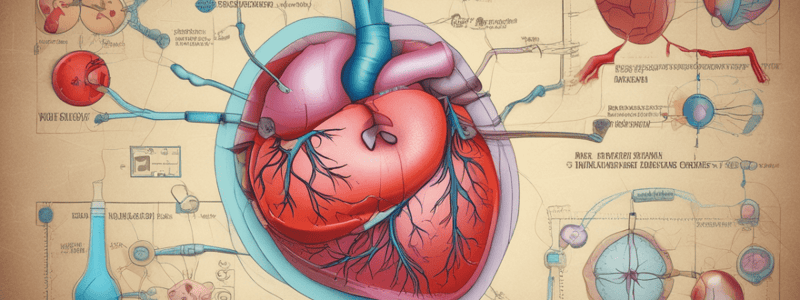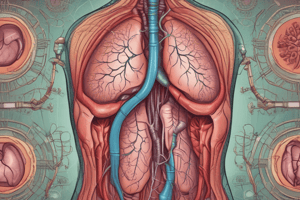Podcast
Questions and Answers
What is the characteristic of vacuolar hepatopathies?
What is the characteristic of vacuolar hepatopathies?
- Hepatocytes become swollen with protein
- Hepatocytes become swollen with fat, glycogen, or water (correct)
- Hepatocytes become swollen with toxins
- Hepatocytes become swollen with antioxidant
What stain is used to detect glycogen in hepatocytes?
What stain is used to detect glycogen in hepatocytes?
- Trichrome
- Oil red O
- Periodic acid Schiff (correct)
- Hematoxylin and eosin
What is the unique feature of steroid hepatopathy in dogs?
What is the unique feature of steroid hepatopathy in dogs?
- Hepatocytes become swollen with fat
- Marked increase in ALP (correct)
- Hepatocytes become swollen with protein
- Marked decrease in ALP
What is the treatment for glycogen-like vacuolar hepatopathy of the Scottish Terrier?
What is the treatment for glycogen-like vacuolar hepatopathy of the Scottish Terrier?
What is the characteristic of hepatic steatosis?
What is the characteristic of hepatic steatosis?
What is the predisposing factor for feline hepatic lipidosis?
What is the predisposing factor for feline hepatic lipidosis?
What is the characteristic of glycogen-like vacuolar hepatopathy of the Scottish Terrier?
What is the characteristic of glycogen-like vacuolar hepatopathy of the Scottish Terrier?
What percentage of hepatocytes with cytoplasmic vacuoles is consistent with feline hepatic lipidosis?
What percentage of hepatocytes with cytoplasmic vacuoles is consistent with feline hepatic lipidosis?
What is the primary underlying mechanism of secondary hepatic lipidosis in cats?
What is the primary underlying mechanism of secondary hepatic lipidosis in cats?
What is the typical ultrasound finding in cats with hepatic lipidosis?
What is the typical ultrasound finding in cats with hepatic lipidosis?
What is the primary goal of early treatment in cats with hepatic lipidosis?
What is the primary goal of early treatment in cats with hepatic lipidosis?
What is the underlying pathogenesis of superficial necrolytic dermatitis in cats?
What is the underlying pathogenesis of superficial necrolytic dermatitis in cats?
What is the most common generalized form of amyloidosis in dogs and cats?
What is the most common generalized form of amyloidosis in dogs and cats?
What is the typical age of presentation for feline hepatic amyloidosis?
What is the typical age of presentation for feline hepatic amyloidosis?
What is the characteristic skin lesion in superficial necrolytic dermatitis?
What is the characteristic skin lesion in superficial necrolytic dermatitis?
What is the primary differential diagnosis for superficial necrolytic dermatitis in cats?
What is the primary differential diagnosis for superficial necrolytic dermatitis in cats?
What is the typical outcome for cats with superficial necrolytic dermatitis?
What is the typical outcome for cats with superficial necrolytic dermatitis?
What is the primary site involved in feline hepatic amyloidosis?
What is the primary site involved in feline hepatic amyloidosis?
Flashcards are hidden until you start studying
Study Notes
Metabolic Diseases of the Liver
Vacuolar Hepatopathies
- Hepatocytes become swollen with fat, glycogen, or water in vacuolar hepatopathies
- Periodic acid Schiff (PAS) stains for glycogen
- Oil red O stains for fat
- Vacuolar change in hepatocytes should prompt search for underlying disease or intoxication
Steroid Hepatopathy
- Occurs with Cushing's or exogenous corticosteroid administration
- Hepatocytes become swollen with glycogen
- Associated with marked increase in ALP (unique to dogs)
- Traditionally considered benign in dogs, but recent reports suggest it may be associated with hepatic remodeling and carcinoma
- Treatment involves removing the source of steroids or using antioxidants like SAMe
Glycogen-like Vacuolar Hepatopathy of the Scottish Terrier
- Characterized by marked increase in ALP and increased risk of hepatocellular carcinoma
- Nearly half of dogs present with clinical signs suggestive of hyperadrenocorticism, but adrenal testing can be negative
- Gallbladder mucocele reported in 16% of cases
- Coarse appearing liver with development of hypoechoic nodules indicative of hepatocyte death
- Affected dogs do not respond to treatment for Cushing's
- Treatment involves antioxidants, monitoring for masses with ultrasound
Hepatic Steatosis
- Accumulation of fat in hepatocytes
- Can occur with toxic injury (fatty degeneration)
- Can occur with primary or secondary disorders of fat metabolism
- Occurs with diabetes
Feline Hepatic Lipidosis
- > 50% of hepatocytes with cytoplasmic vacuoles consistent with lipid
- Obesity, anorexia, and stress are predisposing factors
- Primary form occurs in obese cats that have been anorexic for a period of time without an underlying disease
- Secondary hepatic lipidosis occurs in association with another disease (cholangitis, pancreatitis, IBD, diabetes, cancer)
- Cats with hepatic lipidosis have elevated circulating triglycerides and fatty acids, suggesting lipolysis of fat
- They also have higher beta-hydroxybutyrate levels, suggesting hepatic ketogenesis
- Diagnosis:
- Moderate to marked increases in ALP and bilirubin
- GGT is typically normal
- Hypokalemia common due to prolonged anorexia and vomiting
- Ultrasound shows hyperechoic hepatomegaly
- Fine needle aspirate of the left side to avoid gallbladder
- Careful with biopsies due to hepatic fracture and bleeding with coagulopathy
- Treatment:
- Early intensive feeding is key, usually with tube feeding
- Return to voluntary food intake often takes 12-16 days or longer
- Offer high protein diet
- Likely to require fluid support to correct hydration deficit
- Supplementation with SAMe
- Affected cats often have prolonged coagulation times that may normalize with vitamin K
Gallbladder Mucocele
- Cystic mucinous hyperplasia of the gallbladder wall with accumulation of thick mucous
- Associated with vacuolar hepatopathy
Superficial Necrolytic Dermatitis
- Hepatocutaneous syndrome
- Underlying pathogenesis involves amino acid deficiency
- Typical lesions are hyperkeratotic, erythematous, and ulcerated, often affecting foot pads and mucocutaneous junctions
- Lesions are painful
- Skin biopsies show parakeratotic hyperkeratosis with inter and intracellular edema
- Only ddx is zinc dermatosis
- US shows swiss cheese-like appearance of the liver
- Poor prognosis with death or euthanasia often within 6 months
- Treatment:
- Parenteral amino acid infusion
- High-quality, highly digestible, high-protein diet
- Supplement extra zinc and fatty acids
- Corticosteroids should be avoided
Hepatopathy Caused by Excessive or Abnormal Storage of Metal or Metabolite
- Excessive copper accumulation is an important cause of chronic hepatitis
- Iron overload: hemochromatosis
- All cases in dogs are secondary, resulting from increased iron absorption in the intestine, abnormal iron excretion, or increased hepatic storage secondary to hemolysis
- Reported in dogs with pyruvate kinase deficiency causing hemolytic anemia and repeated blood transfusions
- Characterized by loading of Kupffer cells with hemosiderin, hepatocellular degeneration, and periportal fibrosis progressing to bridging fibrosis and cirrhosis
Alpha-1 Antitrypsin Deficiency
- Alpha-1 antitrypsin is a neutrophil elastase produced in the liver
- Intermediate form of the deficiency was most common in cocker spaniels with chronic hepatitis
Amyloidosis
- Accumulation of aggregated form of amyloid results in disease
- The most common generalized form of amyloidosis in dogs and cats is serum amyloid A (SAA) that occurs with inflammatory disease
- Feline hepatic amyloidosis:
- Hepatic amyloidosis, with liver as primary site involved, occurs more commonly in cats
- Siamese usually present with hepatic involvement, while Abyssinians usually present with renal disease
- Usually young adults
- Most often present due to bleeding from acute hepatic fracture of a friable liver
- Jaundice and hepatomegaly
- Marked elevations in liver enzymes and bilirubin
- Diagnosis from liver biopsy
- Treatment is supportive care and treatment for underlying inflammatory disease
- Canine hepatic amyloidosis:
- Dogs suffer most from renal amyloidosis and most commonly present with PLN
- The multi-organ disease that affects the Chinese Shar Pei can affect the liver, however. Affected Shar Peis are treated with colchicine.
Lysosomal Storage Diseases
- These diseases can cause vacuolation of hepatocytes but primary clinical manifestations are skeletal and neurologic
Studying That Suits You
Use AI to generate personalized quizzes and flashcards to suit your learning preferences.




